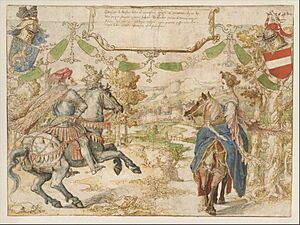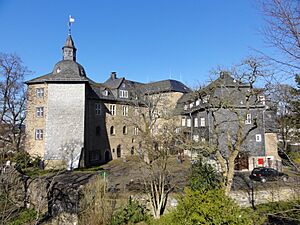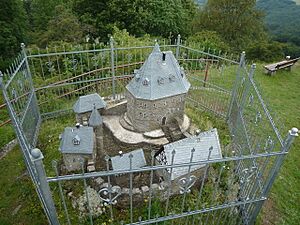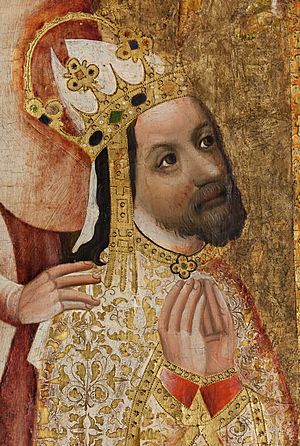Adelaide of Vianden facts for kids
Quick facts for kids
Adelaide of Vianden
|
|
|---|---|
| Countess Consort of Nassau-Siegen | |

Adelaide and her husband Count Otto II. Design drawing by Bernard van Orley for the tapestry from the series with the genealogy of the House of Nassau, 1530–1535
|
|
| Countess Regent of Nassau-Siegen | |
| Coat of arms |  |
| Reign | 1351–1362 |
| Full name |
Adelaide Countess of Vianden
|
| Native name | Adelheid Gräfin von Vianden |
| Born | ? |
| Died | 30 September 1376 |
| Noble family | House of Vianden |
| Spouse(s) | Otto II of Nassau-Siegen |
| Issue Detail |
|
| Father | Philip II of Vianden |
| Mother | Adelaide of Arnsberg |
Adelaide of Vianden was a powerful countess from the House of Vianden. She became the Countess of Nassau-Siegen by marrying Count Otto II of Nassau-Siegen. After her husband died, she ruled Nassau-Siegen as a regent for her young son from 1351 to 1362.
Adelaide was known as a smart and strong leader. She worked hard to end many arguments and fights that her husband had started with other noble families. These families included the powerful lords of Bicken, Walderdorff, and Haiger. Even though she preferred peace, she was ready to fight if she had to. She also managed to pay off many debts her husband had made. In the County of Nassau-Siegen, where local nobles often did what they wanted, she kept things under control.
Contents
About Adelaide's Life
Adelaide was the only daughter of Count Philip II of Vianden and Countess Adelaide of Arnsberg. We don't know exactly when or where she was born.
Her Marriage and Family
Adelaide married Count Otto II of Nassau-Siegen. Their marriage contract was signed on December 23, 1331. Otto was born around 1305 and died between December 1350 and January 1351.
Adelaide and Otto were actually distant relatives. Adelaide's great-great-grandfather was the older brother of Otto's great-grandmother.
Otto became Count of Nassau-Siegen in 1343. He ruled over areas like Siegerland, Mark Herborn, Dillenburg, and Haiger. The next year, he sold some land and a castle to other counts.
Otto was not considered a good ruler. His time as count was filled with many fights, which damaged the country. He often had to sell or promise parts of his land to pay for things. He even lost parts of the city of Siegen and other areas. In 1349, he had to promise the parish of Haiger and half of Ginsburg Castle to other lords. Otto was killed in a battle during his last fight against the Walderdorff brothers. This happened between December 1350 and January 1351. Since their children were still young, Adelaide became the ruler of the county.
Adelaide's Time as Regent
Adelaide was a very good regent. She was smart and strong, and she worked hard to end the many feuds her husband had left behind. These fights were with powerful local families like the Bicken, Walderdorff, and Haiger lords. She wasn't afraid to fight back when necessary.
She also managed to get back many lands that her husband had promised to others. In the County of Nassau-Siegen, where local nobles often acted independently, she kept firm control. She had to promise some land to pay off her husband's debts. Ending these feuds was difficult, but it brought peace for the county to rebuild.
The ongoing feuds and interference from powerful nobles meant she had to take on new debts. Around 1350-1351, she had Tringenstein Castle built. This castle was a defense against a new castle built by the Hessian rulers. She built her castle on land owned by the lords of Bicken and confirmed her rights to the castle hill in 1352. This helped settle a damaging feud with the Bicken family.
In 1352, Adelaide also managed to buy back the part of Siegen city that Nassau had lost. She paid "two thousand old shield guilders" for it. That same year, she made peace with the Walderdorff brothers. They had to release prisoners without payment and become vassals of Nassau. Two years later, in 1354, other nobles who had helped in that feud also made peace with Adelaide under similar conditions. In 1356, Adelaide formed a protection alliance with Landgrave Henry II 'the Iron' of Hesse. This meant all Nassau castles were open to the landgrave during her son's childhood.
In the Haiger area, the noble family of Haiger had been very powerful for a long time. They often resisted the rule of the Counts of Nassau. When Adelaide's son, John, was still a child, the Haiger family thought it was a good time to become completely independent. Heiderich von Haiger even disrespected young John. This led to an open feud, which, as usual, caused a lot of damage to the countryside.
However, Adelaide was brave and determined. She fought back against the Haiger family's actions to protect her son's rights. She received great support from her allies, Landgrave Henry II of Hesse and his son Otto. The fighting was followed by a legal dispute. In 1357, a settlement was reached, which included 63 articles explaining the customs and rights of that time. The land in Haiger and half of Ginsburg Castle, which had been promised to others, were returned. This decision meant the Nassaus won the struggle for control in the Mark Haiger. The lords of Haiger became vassals of the Nassaus. Peace and quiet brought good results in the following years.
From 1359 to 1362, Adelaide and John managed to get back most of the lands that had been promised as security for debts. Holy Roman Emperor Charles IV owed Count Otto money. So, the Emperor gave them the right to collect some tolls from water or land. This often meant increasing the toll fees, which could harm trade. Adelaide and her son tried to collect this debt from the tolls of the Electorate of Mainz at Oberlahnstein. They also had older claims against the Electorate of Mainz.
As often happened, this led to another feud. In the autumn of 1362, Archbishop Gerlach of Nassau invaded Nassau-Siegen with 500 horsemen and many foot soldiers. The soldiers looted and destroyed the county. They had to retreat when floods came to avoid being trapped. In December of the same year, Gerlach and John signed a peace treaty. Gerlach promised to pay 3500 florins and allow John to collect tolls from Oberlahnstein until he received 2000 florins. Also in 1362, Adelaide officially handed over the rule to her eldest son, John.
Adelaide died on September 30, 1376. We don't know where she was buried.
Her Legacy
When Elisabeth of Sponheim-Kreuznach, Countess of Vianden, died in 1417 without children, Adelaide's grandsons inherited the County of Vianden. They also gained control of areas like St. Vith, Bütgenbach, Dasburg, and Grimbergen. Today, the King of the Netherlands still holds the titles of Count of Vianden and Lord of St. Vith, Bütgenbach, and Dasburg.
The certification mark of the steel from Siegen became the coat of arms of the County of Vianden. Blacksmiths hammered this symbol into the steel for generations. This steel, with its special mark, was then sold all over the world.
Adelaide's Children
Adelaide and Otto had the following children:
- Count John I (born around 1339 – died September 4, 1416). He took over as Count of Nassau-Siegen after his father. He married Countess Margaret of the Mark in 1357.
- Henry 'the Swashbuckler' (died September 5, 1402). He was a church official (a canon) at the Cologne Cathedral from 1356. Even though he was a clergyman, he was known as a fierce fighter, which is why he got the nickname 'the Swashbuckler'. He sometimes even fought with his older brother, John.
- Otto (died 1384). He was also a church official and provost at Saint Maurice Church in Mainz from 1357. He also became a canon at the Cologne Cathedral and the Mainz Cathedral in 1380.






